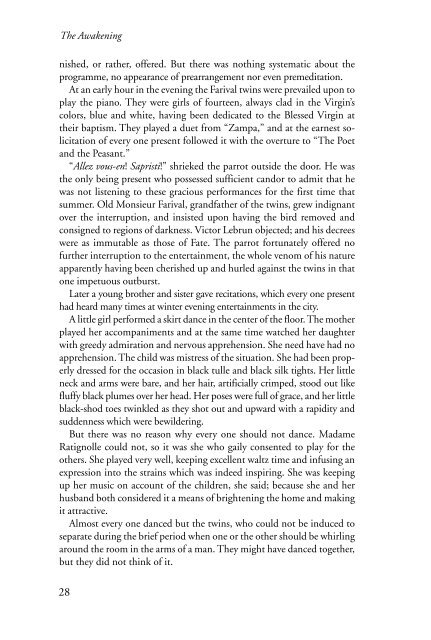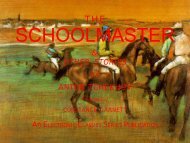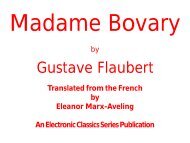The Awakening Kate Chopin - Penn State University
The Awakening Kate Chopin - Penn State University
The Awakening Kate Chopin - Penn State University
Create successful ePaper yourself
Turn your PDF publications into a flip-book with our unique Google optimized e-Paper software.
<strong>The</strong> <strong>Awakening</strong><br />
nished, or rather, offered. But there was nothing systematic about the<br />
programme, no appearance of prearrangement nor even premeditation.<br />
At an early hour in the evening the Farival twins were prevailed upon to<br />
play the piano. <strong>The</strong>y were girls of fourteen, always clad in the Virgin’s<br />
colors, blue and white, having been dedicated to the Blessed Virgin at<br />
their baptism. <strong>The</strong>y played a duet from “Zampa,” and at the earnest solicitation<br />
of every one present followed it with the overture to “<strong>The</strong> Poet<br />
and the Peasant.”<br />
“Allez vous-en! Sapristi!” shrieked the parrot outside the door. He was<br />
the only being present who possessed sufficient candor to admit that he<br />
was not listening to these gracious performances for the first time that<br />
summer. Old Monsieur Farival, grandfather of the twins, grew indignant<br />
over the interruption, and insisted upon having the bird removed and<br />
consigned to regions of darkness. Victor Lebrun objected; and his decrees<br />
were as immutable as those of Fate. <strong>The</strong> parrot fortunately offered no<br />
further interruption to the entertainment, the whole venom of his nature<br />
apparently having been cherished up and hurled against the twins in that<br />
one impetuous outburst.<br />
Later a young brother and sister gave recitations, which every one present<br />
had heard many times at winter evening entertainments in the city.<br />
A little girl performed a skirt dance in the center of the floor. <strong>The</strong> mother<br />
played her accompaniments and at the same time watched her daughter<br />
with greedy admiration and nervous apprehension. She need have had no<br />
apprehension. <strong>The</strong> child was mistress of the situation. She had been properly<br />
dressed for the occasion in black tulle and black silk tights. Her little<br />
neck and arms were bare, and her hair, artificially crimped, stood out like<br />
fluffy black plumes over her head. Her poses were full of grace, and her little<br />
black-shod toes twinkled as they shot out and upward with a rapidity and<br />
suddenness which were bewildering.<br />
But there was no reason why every one should not dance. Madame<br />
Ratignolle could not, so it was she who gaily consented to play for the<br />
others. She played very well, keeping excellent waltz time and infusing an<br />
expression into the strains which was indeed inspiring. She was keeping<br />
up her music on account of the children, she said; because she and her<br />
husband both considered it a means of brightening the home and making<br />
it attractive.<br />
Almost every one danced but the twins, who could not be induced to<br />
separate during the brief period when one or the other should be whirling<br />
around the room in the arms of a man. <strong>The</strong>y might have danced together,<br />
but they did not think of it.<br />
28

















